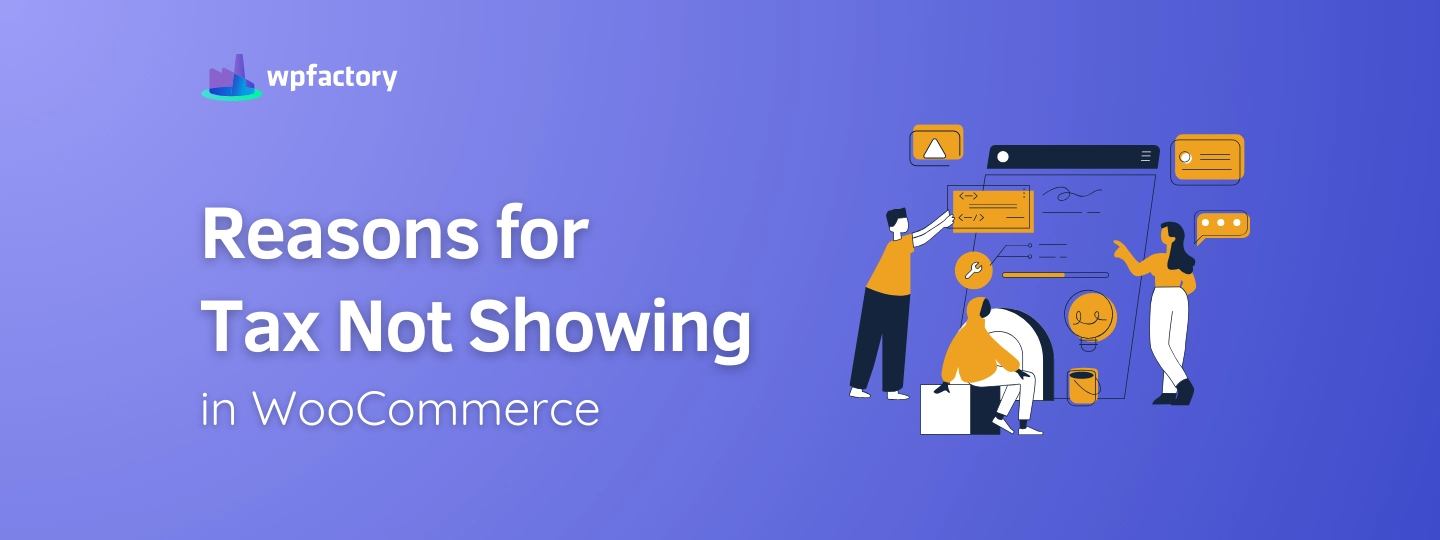5 Reasons for Tax Not Showing in Cart & Checkout for WooCommerce
A few code errors in your online store could make you lose hundreds or even thousands of dollars per month, that’s not a fun experience.
Some errors could impact your conversion rates and decrease your profitability by failing to attract and retain customers, these kinds of errors may be complex and hard to fix because several factors are involved in them.
But other errors are urgent and need to be fixed immediately, they are like a hole in your pocket, and you keep losing money no matter how much you put in it.
The error of sales taxes not showing in WooCommerce is one of these types of errors where it’s a hole in your pocket that needs to be fixed immediately.
That’s exactly what we are going to do in this article.
Reasons Why Sales Tax is not Showing in WooCommerce:
There are 5 possible reasons why your sales tax isn’t showing up in your WooCommerce store:
- An error in WooCommerce tax configuration
- Outdated WordPress version
- Extension compatibility error
- Plugin conflicts
- Check WooCommerce database
Let’s discuss them one by one.
1. WooCommerce Tax Configuration Error
Tax calculation problems may arise if certain fields on your WooCommerce tax settings page have not been completed correctly. To prevent any errors during checkout, make sure to fill them out accurately. To do this:
- Navigate to WooCommerce >> Settings to access the plugin’s Settings page.
- Go to the “General” tab and scroll down to the “General Options” section. Once you’re there, make sure to check the box labeled “Enable tax rate…“. This step allows you to set up WooCommerce tax rates by enabling the tax options menu.
- After completing the necessary adjustments, scroll down and select the “Save Changes” button.
- Now, navigate to the “Tax” tab and ensure proper configuration.
For instance, if you opt to display prices exclusive of tax, make sure to include tax rates in the “display prices during cart and checkout” box.
Proceed to set up additional tax options such as Additional tax classes, shipping tax class, etc. You can consult the official WooCommerce documentation for a comprehensive tutorial on configuring taxes for your eCommerce website.
Once you have entered the accurate tax settings, click on the Save Changes button and verify the functionality of your tax options.
If ensuring all criteria are filled still does not resolve the issue, then the problem with your WooCommerce tax functionality might be related to a plugin.
2. Outdated WordPress Version
Emphasizing the importance of keeping your WordPress site and WooCommerce software updated cannot be overstated. We understand it can be inconvenient.
However, this inconvenience serves to protect your website from risks and potential issues, such as the problem of WooCommerce tax rates not functioning correctly.
For those operating a WooCommerce store, maintaining updated software is crucial. Neglecting updates increases the likelihood of encountering conflicts. This is because an outdated version may not fully support certain features within your WordPress installation.
Therefore, before attempting any other troubleshooting steps, ensure to update both your WordPress core and the WooCommerce plugin. To do this:
- Navigate to Dashboard
- Updates in your WordPress admin panel.
- From there, click the button to install the latest version of WordPress on your website.
Following that, navigate to the “Plugins” section. If an update is available for your WooCommerce plugin, you’ll find the option to update it listed here.
While in this section, you can also update all other plugins. Simply select the “Select All” checkbox and proceed to click on “Update Plugins” to initiate the updates.
Verify your site to confirm if tax rates are functioning properly. If they are not operating as expected, continue reading for alternative solutions to this issue.
3. Extension Compatibility Error
Prior to adding or updating any WooCommerce extensions on your website, ensure that they have been tested with the most recent version of WordPress. Failing to do so, especially if the extension is already installed on your site, could lead to issues with WooCommerce tax rates.
To address this:
- Navigate to Plugins
- Installed Plugins and identify all plugins with WooCommerce in their names.
- Check each one, then choose Bulk Actions
- Deactivate from the top menu and click Apply.
Once your extensions are deactivated, proceed to test the tax functionality by checking out with a product. If taxes are applied correctly, it indicates that one of your extensions was causing the issue.
To pinpoint the problematic extension, systematically reactivate each extension one at a time. After activating each extension, verify if taxes are still functioning properly. The extension that triggers the tax malfunction upon activation is the one causing the problem. You’ll need to uninstall it and either find a suitable replacement or contact WooCommerce for further assistance.
4. Plugin Conflicts
A potential reason for your WooCommerce tax rates malfunctioning could stem from a plugin conflict. Such conflicts might arise if you’re using outdated plugins. Moreover, errors may occur if an update for one of your plugins isn’t compatible with your WooCommerce extension. You can refer to our guide on avoiding plugin conflicts for further assistance.
To pinpoint the troublesome plugin, it’s necessary to deactivate all plugins on your site except WooCommerce. This procedure is a continuation of the WooCommerce extension troubleshooting process.
To do this:
- log in to your WordPress dashboard and navigate to Plugins.
- Installed Plugins.
- Then, select the checkbox next to ‘Plugins’, which will choose all plugins installed on your site. Now look for WooCommerce and untick it.
- Click on Bulk Actions to unveil the drop-down menu. From there, choose Deactivate. Subsequently, click on the Apply button adjacent to it to deactivate all plugins.
Now, visit your store and verify if taxes are functioning correctly. If they are, then one of your plugins is likely at fault. To identify the problematic plugin, you’ll need to troubleshoot them manually.
To do this, reactivate your plugins one by one to pinpoint the one causing the tax rate issue. After activating each plugin, ensure to check if the taxes are being calculated accurately.
The plugin you activated before the issue reappeared is the culprit. You can choose to either remove it and search for an alternative plugin or report the issue to its developers.
5. Check WooCommerce Database
If other troubleshooting steps prove ineffective and taxes continue to not function correctly, it may be necessary to examine your WooCommerce database tables. Begin by consulting the WooCommerce documentation to confirm which tables should be present after setup. Following this, access your website’s cPanel and verify if all the required tables are listed.
One potential issue could be the absence of the “WooCommerce_tax_rate_locations” table within the tax tables, preventing the execution of necessary commands.
To address this, you may need to create the missing database table. One straightforward method is to deactivate and reactivate your WooCommerce plugin, which should restore all default WooCommerce tables in your database.
If this approach doesn’t resolve the issue, you might need to manually create the table. However, this task requires proficiency in WordPress and database management. If you’re not comfortable with database operations, consider hiring a professional to assist you.
To manually create the table, you’ll need to add SQL code to your database. Before proceeding, it’s crucial to back up your database to prevent data loss.
To create the table:
- log in to the cPanel of your WordPress hosting account.
- Then, navigate to the “Databases” section and access phpMyAdmin.
- In phpMyAdmin, choose the database associated with your WordPress site. Then, navigate to the SQL tab and click on it.
In the editor, insert the following code:
CREATE TABLE wp_woocommerce_tax_rate_locations ( location_id bigint(20) NOT NULL, location_code varchar(255) NOT NULL, tax_rate_id bigint(20) NOT NULL, location_type varchar(40) NOT NULL ) ENGINE=InnoDB DEFAULT CHARSET=utf8;
- Once you’ve inserted the code, click the “Go” button to apply your modifications.
- Return to your WordPress dashboard and navigate to WooCommerce >> Settings.
- In this section, scroll down and select the “Save Changes” button. This action will populate the new table with the required details.
Following this, verify your website to ensure that your WooCommerce tax rate is functioning correctly.
EU VAT for WooCommerce
Relationship Between Payment Issues and Tax
Conclusion
Setting up WooCommerce is typically straightforward and user-friendly. Despite offering an excellent experience for store owners, occasional issues may arise. That’s why our team is dedicated to providing solutions for common WooCommerce errors.
In this guide, we’ve demonstrated how to address the WooCommerce tax not working issue. Beginning with simple solutions such as updating your WooCommerce and WordPress software, you can gradually explore more complex troubleshooting steps if the problem persists.
If you require further assistance, don’t hesitate to reach out to our team of WordPress experts for additional guidance.









